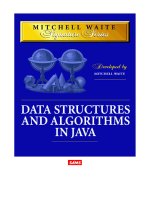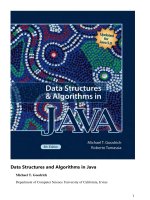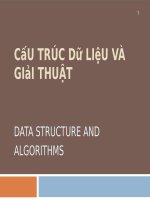Data Structure and Algorithms CO2003 Chapter 5 Stack and Queue
Bạn đang xem bản rút gọn của tài liệu. Xem và tải ngay bản đầy đủ của tài liệu tại đây (1.75 MB, 93 trang )
Data Structure and Algorithms [CO2003]
Chapter 5 - Stack and Queue
Lecturer: Duc Dung Nguyen, PhD.
Contact:
September 19, 2016
Faculty of Computer Science and Engineering
Hochiminh city University of Technology
Contents
1. Basic operations of Stacks
2. Implementation of Stacks
3. Applications of Stack
4. Basic operations of Queues
5. Implementation of Queue
6. Applications of Queue
1
Outcomes
• L.O.2.1 - Depict the following concepts: (a) array list and linked list, including single link
and double links, and multiple links; (b) stack; and (c) queue and circular queue.
• L.O.2.2 - Describe storage structures by using pseudocode for: (a) array list and linked
list, including single link and double links, and multiple links; (b) stack; and (c) queue and
circular queue.
• L.O.2.3 - List necessary methods supplied for list, stack, and queue, and describe them
using pseudocode.
• L.O.2.4 - Implement list, stack, and queue using C/C++.
2
Outcomes
• L.O.2.5 - Use list, stack, and queue for problems in real-life, and choose an appropriate
implementation type (array vs. link).
• L.O.2.6 - Analyze the complexity and develop experiment (program) to evaluate the
efficiency of methods supplied for list, stack, and queue.
• L.O.8.4 - Develop recursive implementations for methods supplied for the following
structures: list, tree, heap, searching, and graphs.
• L.O.1.2 - Analyze algorithms and use Big-O notation to characterize the computational
complexity of algorithms composed by using the following control structures: sequence,
branching, and iteration (not recursion).
3
Basic operations of Stacks
Linear List Concepts
General list:
• No restrictions on which operation can be used on the list.
• No restrictions on where data can be inserted/deleted.
Restricted list:
• Only some operations can be used on the list.
• Data can be inserted/deleted only at the ends of the list.
4
Linear list concepts
5
Stack
Definition
A stack of elements of type T is a finite sequence of elements of T, in which all insertions and
deletions are restricted to one end, called the top.
Stack is a Last In - First Out (LIFO) data structure.
LIFO: The last item put on the stack is the first item that can be taken off.
6
Basic operations of Stacks
Basic operations:
• Construct a stack, leaving it empty.
• Push an element: put a new element on to the top of the stack.
• Pop an element: remove the top element from the top of the stack.
• Top an element: retrieve the top element.
7
Basic operations of Stacks
Extended operations:
• Determine whether the stack is empty or not.
• Determine whether the stack is full or not.
• Find the size of the stack.
• Clear the stack to make it empty.
8
Basic operations of Stacks: Push
Figure 1. Successful Push operation
9
Basic operations of Stacks: Push
Figure 2. Unsuccessful Push operation. Stack remains unchanged.
10
Basic operations of Stacks: Pop
Figure 3. Successful Pop operation
11
Basic operations of Stacks: Pop
Figure 4. Unsuccessful Pop operation. Stack remains unchanged.
12
Basic operations of Stacks: Top
Figure 5. Successful Top operation. Stack remains unchanged.
13
Basic operations of Stacks: Top
Figure 6. Unsuccessful Top operation. Stack remains unchanged.
14
Implementation of Stacks
Linked-list implementation
15
Linked-list implementation
Stack structure
stack
c o u n t <i n t e g e r >
t o p <node p o i n t e r >
end s t a c k
Stack node structure
node
d a t a <dataType>
n e x t <node p o i n t e r >
end node
16
Linked-list implementation in C++
t e m p l a t e < c l a s s ItemType>
s t r u c t Node {
ItemType d a t a ;
Node<ItemType> ∗ n e x t ;
};
17
Linked-list implementation in C++
template <c l a s s List_ItemType>
c l a s s Stack {
public :
Stack ( ) ;
~Stack ( ) ;
v o i d Push ( L i s t _ I t e m T y p e d a t a I n ) ;
i n t Pop ( L i s t _ I t e m T y p e &dataOut ) ;
int
GetStackTop ( L i s t _ I t e m T y p e &dat aOut ) ;
void Clear ( ) ;
int
IsEmpty ( ) ;
int
GetSize ( ) ;
S t a c k <L i s t _ I t e m T y p e >∗ C l o n e ( ) ;
void Print2Console ( ) ;
private :
Node<L i s t _ I t e m T y p e >∗ t o p ;
i n t count ;
};
18
Create an empty Linked Stack
19
Create an empty Linked Stack
Algorithm createStack(ref stack <metadata>)
Initializes the metadata of a stack
Pre: stack is a metadata structure of a stack
Post: metadata initialized
stack.count = 0
stack.top = null
return
End createStack
20
Create an empty Linked Stack
template <c l a s s List_ItemType>
S t a c k <L i s t _ I t e m T y p e > : : S t a c k ( ) {
t h i s −>t o p = NULL ;
t h i s −>c o u n t = 0 ;
}
template <c l a s s List_ItemType>
S t a c k <L i s t _ I t e m T y p e >::~ S t a c k ( ) {
t h i s −>C l e a r ( ) ;
}
21
Push data into a Linked Stack
1. Allocate memory for the new node and set up data.
2. Update pointers:
• Point the new node to the top node (before adding the new node).
• Point top to the new node.
3. Update count
22









![microsoft silverlight 5 data and services cookbook [electronic resource] over 100 practical recipes for creating rich, data-driven, business applications in silverlight 5](https://media.store123doc.com/images/document/14/y/ev/medium_neP7R4h80c.jpg)